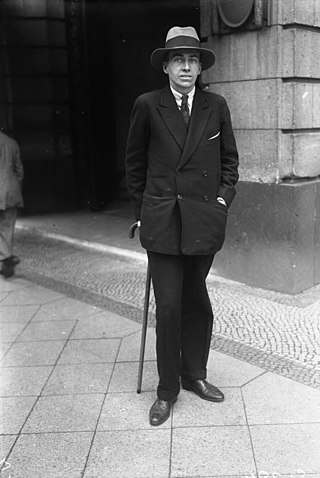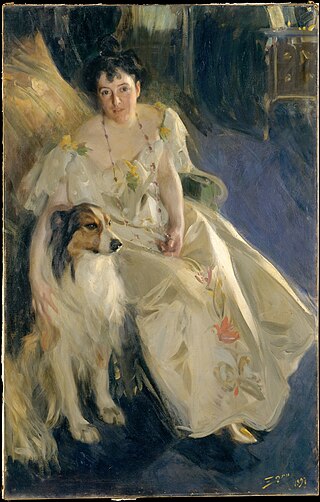
Cornelius Vanderbilt, nicknamed "the Commodore", was an American business magnate who built his wealth in railroads and shipping. After working with his father's business, Vanderbilt worked his way into leadership positions in the inland water trade and invested in the rapidly growing railroad industry, effectively transforming the geography of the United States.

From the late 1870s to the 1920s, the Vanderbilt family employed some of the best Beaux-Arts architects and decorators in the United States to build an unequaled string of townhouses in New York City and palaces on the East Coast of the United States. Many of the Vanderbilt houses are now National Historic Landmarks. Some photographs of Vanderbilt residences in New York are included in the Photographic series of American Architecture by Albert Levy (1870s).

Alfred Gwynne Vanderbilt Sr. was a wealthy American businessman, and a member of the Vanderbilt family. A sportsman, he participated in and pioneered a number of related endeavors. He died in the sinking of the RMS Lusitania.
George Browne Post was an American architect trained in the Beaux-Arts tradition. He was recognized as a master of modern American architecture as well as being instrumental in the birth of the skyscraper.

The Canada Southern Railway, also known as CSR, was a railway in southwestern Ontario, Canada, founded on February 28, 1868 as the Erie and Niagara Extension Railway. Its name was changed to Canada Southern Railway on December 24, 1869. The 1868 Act specified that it was to be constructed at a broad gauge of 5 ft 6 in, but that requirement was repealed in the 1869 Act, thus allowing construction at the standard gauge of 4 ft 8+1⁄2 in.

Cornelius Vanderbilt IV was a newspaper publisher, journalist, author, and military officer. He was an outcast of high society, and was disinherited by his parents when he became a newspaper publisher. He desired to live a "normal" life but was burdened by large debt and could not maintain the lifestyle associated with his family's social position to which he had become accustomed.

The Knickerbocker Club is a gentlemen's club in New York City that was founded in 1871. It is considered to be the most exclusive club in the United States and one of the most aristocratic gentlemen's clubs in the world.
Dick, Kerr and Company was a locomotive and tramcar manufacturer based in Kilmarnock, Scotland and Preston, England.
The Peithologian Society was an undergraduate debate society at Columbia University. It was founded in 1806, four years after Columbia's first literary society, the Philolexian Society, by freshmen who were disenfranchised by Philolexian's requirement that its members be upperclassmen. Its emphasis on debate, composition, and rhetoric was similar to Philo's literary aims, and the two societies shared other superficial characteristics as well. Philo adopted light blue as its official color, while Peithologian adopted white. Whereas Philolexian's symbol was a rising sun, Peithologian's was a star. Its Latin motto was "Vitam Impendere Vero" meaning, roughly, "To devote one's life to truth."
The Imperial Tramways Company Ltd was created to bring under common management a number of street tramways. Originally based in London, its headquarters moved to Bristol in 1892 and from then on it shared its senior management with Bristol Tramways under the chairmanship of George White.

Tramways in Exeter were operated between 1882 and 1931. The first horse-drawn trams were operated by the Exeter Tramway Company but in 1904 the Exeter Corporation took over. They closed the old network and replaced it with a new one powered by electricity.

Charles Bell FRIBA (1846–99) was a British architect who designed buildings in the United Kingdom, including over 60 Wesleyan Methodist chapels.

Virginia Purdy Bacon was an American heiress and art dealer.

Edward Rathbone Bacon was president of a railroad, lawyer and financier. His father was David Rinaldo Bacon and his mother was Elizabeth Rathbone. He had four siblings, Walter Rathbone, Lathrup Rufus, John Ganson, and Mary Sibley Bacon. Bacon never married or had children. Bacon served as the vice-president of the Baltimore and Ohio Railroad, and as the president of the Baltimore and Ohio Southwestern Railroad. He also worked as a lawyer and financier. Bacon died on December 2, 1915 in Baltimore, Maryland as a result of an appendicitis operation he had a week earlier.
Paul Siegvolk was an American author, lawyer and editor. He was also the step-father of Alice Claypoole Vanderbilt.

Henry Keep was an American currency speculator, banker, stock speculator, and railroad financier who invested heavily in the Chicago and North Western Railway, Cleveland and Toledo Railroad, Michigan Southern and Northern Indiana Railroad, and New York Central Railroad. He was treasurer of the Michigan Southern and Northern Indiana Railroad from 1861 to 1863, and briefly president of the New York Central Railroad in 1866.

Edmund Lincoln Baylies, Jr. was a New York City lawyer, philanthropist, and member of New York Society during the Gilded Age.
Marshall Orme Wilson Jr. was an American diplomat and member of the Astor family.
Abraham Burtis Baylis Sr. was an American businessperson who served as president of the New York Stock Exchange during the U.S. Civil War.












